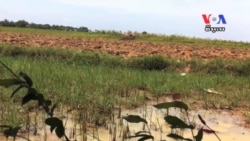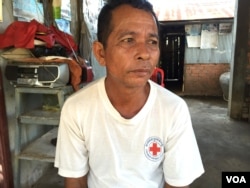OMPIL PA-EM VILLAGE, KANDAL PROVINCE, CAMBODIA - Long Thon is a rice farmer here in Kandal province, just 40 kilometers outside Phnom Penh. Like many Cambodians, she lives a life with few safety margins. In most years, she can feed her family and make a living from the three acres of land she farms on the sweeping plains outside the capital, where on a typical year big rainstorms roll in during the summer monsoon. This year, though, it’s been too dry.
“Water from the river did not flow into the canals,” Long Thon, a mother of four, told VOA Khmer in a recent interview. “The rice field is dry, because there was no rain, so we cannot grow rice.” No rice means no income, and that means her children can’t attend school, she said. “Only the grass is growing.”
Cambodians like Long Thon understand that Cambodia’s climate is changing, but few understand why. But as governments prepare to gather for climate talks that open Nov. 30 in Paris, countries like Cambodia are likely to demand more funding from industrialized nations whose carbon emissions are leading contributors to global warming.
“I’ve never experienced this before,” Long Thon said of the dry year. “There’s no rain. There’s no flood. There’s no rice in the dry season. There’s no rice in the rainy season. I don’t know what to do. I might try to find some vegetables to pick here and there, but if I can’t get any, I might beg for money.”
Cambodia is ranked one of the most vulnerable countries in the world to climate change. Many of its people rely on agriculture, and the changes to the country’s climate, whether more droughts or more floods, makes them particularly vulnerable.
In Asia, Cambodia ranks with Bangladesh and the Philippines, in terms of its exposure to climate change, in large part due to its dependence on a changing monsoon.
According to UNDP statistics, 22,695 Cambodians out of a million were impacted by natural disasters in the country between 2005 and 2012, especially flood and drought. Cambodia’s population of more than 15 million, leaving hundreds of thousands vulnerable to the changing climate. That’s because a warmer world means a change in fundamental hydrological cycles, including the monsoon, which is a major part of Cambodia’s annual farming almanac. Climate research suggests that more countries can expect more droughts and more floods as this cycle changes. And because Cambodia has so little infrastructure and other mitigation methods, it has little recourse.
“Cambodia is consistently ranked among the top ten countries most vulnerable to climate change, and among the three most vulnerable in Asia,” according to the UNDP, which supports the Cambodia Climate Change Alliance program. “This is due in large part to a relatively low captive capacity.”
That puts Cambodia at the bottom of the Global Climate Risk Index, put together by Germanwatch, a think tank. “In recent years, countries including Cambodia and Vietnam have regularly appeared in the bottom 10 list, and this year was no exception,” according to Germanwatch’s 2015 index. “Cambodia’s ranking is connected with 2013’s particularly severe monsoon season, which induced heavy rainfall and widespread flooding throughout a country that was still recovering from the damage of previous year’s floods.”
With more than 2 million families, or 80 percent of the population, relying on agriculture to making a living, that’s a lot of risk.
“The Ministry of Water Resources says that the water level in the Mekong and Tonle Sap rivers, and Tonle Sap lake, is very low [compared over] the last 50 years,” said Keo Vy, a spokesman for the National Committee on Disaster Management. “That’s because of not much rain.”
But even if changes are easy to see, they are hard to understand, and Cambodia’s adaptation options are few. Sao Sopheap, a spokesman for the Environment Ministry, told VOA Khmer that Cambodia will seek financial aid from developed countries for adaptation. “We have to have a program to educate vulnerable people,” he said.
That would include Long Thon and her neighbors. Nget Lat, the village chief of Ompil Pa’em, in Kandal’s Ponhea Leu district, said 105 families there are facing water shortages this year, not just for farming but for daily use—even though the village is not far from a major river, the Tonle Sap. The more than 400 people in the village have had to start buying water, spending at least a dollar a day on a jug of water, enough to meet their needs for a day. With the dry season approaching, their water needs are only going to increase, Nget Lat said.
“All of the families need water,” he said. “They’re all buying water, since there is no water system to the houses. I would like to make a request to the national level to set up a system of pipes for household water use.”
Whether it’s for mitigation or adaptation to climate change, Cambodia will need help from industrialized countries, like the US, which are mostly responsible for contributing to global warming.
Tek Vannara, director of the NGO Forum in Phnom Penh, who will attend the climate talks in Paris, told VOA Khmer that such countries need to help developing nations with technology and financial support.
“We will make a request to the industrialized, developed countries to help reduce greenhouse gas emissions,” he said. “We also ask that they increase their country budgets and development budgets related to adaptation to climate change, for $100 billion per year. “This would allow civil society organizations in developing countries to be able to propose packages on adaptation to climate change.”
He also wants to see a market for carbon credits, to help preserve what remains of Cambodia’s forests, which can act as a carbon sink, removing carbon dioxide from the atmosphere to curb warming.
In 2013, the Cambodian government put out a climate change strategy, noting at the time major changes over the last half of the 20th century. Cambodia faces risks of extreme weather, drought, floods, heat waves, and coastal flooding. “The forecast for the next 80 years shows that the heat will keep rising with less rain in the dry season, and the rainy season will be delayed,” the plan says. “At the same time, the level of rain will go higher. The change is various, depending on the amount of greenhouse gas emissions.”
Flooding in 2009, 2011 and 2013 led to more than $1 billion in damages and 461 fatalities. Those are major costs for a country that produces relatively little greenhouse gas emissions. And now, with the drought, costs are mounting for Long Thon and other Cambodian farmers.
Long Thon, the rice farmer and mother, told VOA Khmer the solution is simple: an irrigation system that can buffer against bad weather. That could even improve her lot in life, she said. “Only when there is an irrigation system can I grow rice,” she said. “If there were one, then I could grow water spinach.”












